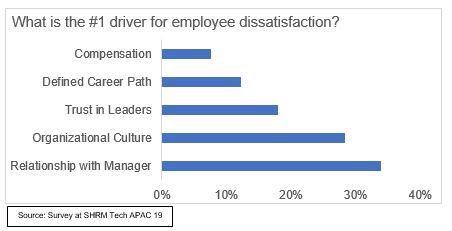Creating an Effective Digital Employee Experience and Engagement Strategy
Creating an Effective Digital Employee Experience and Engagement Strategy
This Article based on a Panel discussion at SHRM HR Tech APAC 2019, moderated by Ranjit Jose - Co-Founder & CRO at Hyphen. Panelists: Sandeep Gautam, Executive Director HR at Spencer's Retail Limited, Sanjay Virmani, CHRO at Tata Steel and Raj Narayan, CHRO at Titan.
Perspectives and experiences on crafting employee engagement and employee experience strategies
As a large food retail chain, Spencer's Retail Ltd. has emphasized on creating actively engaged employees through effective communication. Spencer Retail conducts annual engagement surveys to better understand their employees' mind-set and drive initiatives. In order to improve the human touch, the organization has launched initiatives in the form of structured one-on-one, pulse meetings, which research shows creates more engaged employees and delivers greater customer engagement.
Sandeep Gautam, Executive Director HR at Spencer's Retail Limited, shares that with attrition levels as high as 70% for the front-line employees, the organization is in the process of evaluating technology platforms to help address issues. Spencer Retail plans to leverage technology to capture real-time data and get insights on employees in order to take measures to retain them. Disengaged employees and high attrition rates are bad for business and he believes that organizations must leverage technology without losing the human touch to address this problem.
At Tata Steel employee engagement is not a new subject. Sanjay Virmani, CHRO at Tata Steel shares that the concept of employee engagement has existed in the organization for over 100 years. It is only in the last decade that the company has begun measuring engagement to meet the growing complexity of their business. Tata Steel is becoming more multi-dimensional and multi-locational due to organic and inorganic growth, new acquisitions, and an increasing focus on diversity & inclusion, as well as the increasing proportion of millennials in the workforce. "We (HR) understood the need to connect the dots to get a holistic view while at the same time segmenting employees across locations to understand the different interventions required," said Virmani. "The management and leadership are involved in the decisions and even spearhead them."
Raj Narayan, CHRO at Titan, affirms that HR must understand the business's needs and gaps. "HR should be able to identify areas that require tech-based interventions and the overall IT landscape before identifying tools available in the marketplace."
Titan is a multiple category company in the lifestyle space that designs, manufactures, sources, sells, distributes, markets and engages in retail and after-sales services in watches, jewelry and B2B components. Cracking the code with engagement requires the organization to understand what motivates employees across these varied functions. Titan approaches engagement at 3 different levels
- Individual businesses
- Function within each business
- Individual employee
Narayan shares that the measurement of engagement and numbers is just one part and focusing only on this means the HR department and top management are looking at the wrong end of the tunnel. "What is critical is what we do with the numbers," states Narayan. While doing the usual annual surveys, Titan also lays emphasis on action planning at all levels. Titan's HR engages with employees at a team member level to understand what will make them more engaged. Titan has daily and 6-monthly pulse surveys to capture the constant mood changes in the retail business through simple, short surveys at the stores.
At Titan, open communication is the key to ensuring engagement. Titan has an anonymous portal for employees to share issues and give suggestions. The most critical part of engagement is turning insights, measurements and suggestions into action.
Factors contributing to employee dissatisfaction and disengagement

At Tata Steel, HR also captures the experiences of opinion leaders (customers, suppliers, partners, etc.) apart from their employees. Sanjay Virmani further adds, "It is crucial for managers to engage with the new workforce, using technology and consistent approaches (formal and informal) to capture the voices and concerns of people, gaining meaningful insights."
Employee engagement strategies
At Spencer's Retail, 70% of the workforce is below 30 years of age and at Tata Steel, 60% of the workforce is below 32 years of age. It is important to factor in the generational shift when creating an engagement strategy. Here are a few tips from our experts:
- Policies must be reviewed consistently, based on the insights and suggestions for different employee segments. For instance, millennials seek sabbaticals and breaks to study and retirement benefits may not engage them enough.
- Inclusion and diversity are becoming significant concerns in Indian companies. It is important to capture the needs of newer segments of employees.
- The gig economy is gaining momentum in India and HR Policies must include initiatives such as flexi-timing, remote work, part-time work, satellite policy, coaching and mentoring.
- Leverage technology to create robust monitoring and feedback systems. This is essential to ensure that policies and initiatives are implemented as intended.
- Have an open-door policy and connect with employees at the grass-root level. Town halls and pulse meetings are great ways to creating trust and transparency within the organization.
- Implement campus and internship programs to understand what future employees expect from the workplace.
How do you tie employee engagement with business results?
Ranjit Jose believes, "Employee engagement is very important, but it must serve a business purpose/ need."
It is crucial to choose the right set of metrics to establish the correlation between engagement and business results. We must identify patterns and convert them into actions.
An organization run by AI is not a futuristic concept. Such technology is already a part of many workplaces and will continue to shape the labor market and HR. Here's how employers and employees can successfully manage generative AI and other AI-powered systems.



